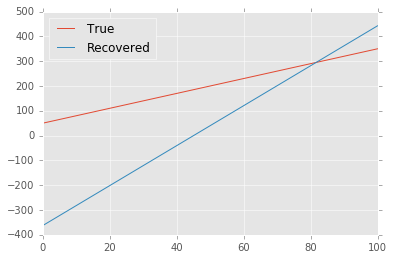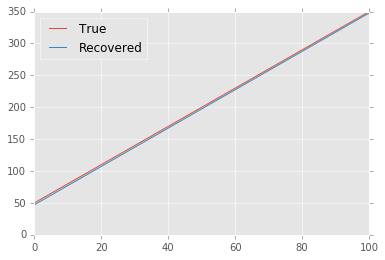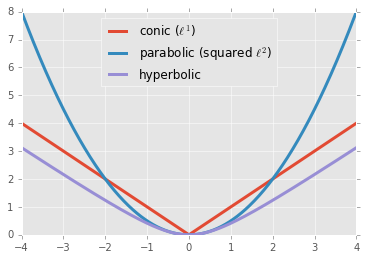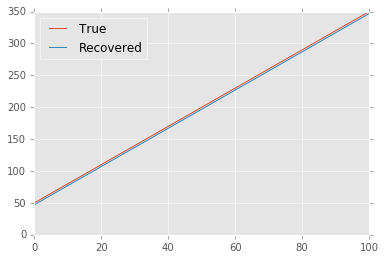Dealing with heavy-tailed noise: the Japanese bracket cost function
Update (April 18, 2016): For a more detailed mathematical analysis, see this post.
Update (April 17, 2016): What I call the Japanese bracket cost function below seems to already be known as the Pseudo-Huber loss function. See this Wikipedia page for references.
Background and motivation
Many machine-learning problems can be formulated as minimizing a training cost plus a regularization cost. The simplest example is linear regression, in which for training data $X$ and labels $y$, one seeks to solve the problem:
Here $W$ and $b$ are the coefficients to be fitted and $C$ is a hyperparameter that controls the strength of the regularization.
Two widely-used cost functions are the squared $\ell^2$ norm and the $\ell^1$ norm. If $z$ is an $n$-dimensional vector, these are given by:
For example, the squared-$\ell^2$ norm is used as both the cost and regularization cost in Ridge regression, and in Lasso regression, the squared-$\ell^2$ norm is still used for the training cost, but the $\ell^1$ norm is used for regularization. (The motivation for using $\ell^1$ in this context is to make $W$ sparse.)
The purpose of this article is:
- To raise awareness that for heavy-tailed noise the squared $\ell^2$ norm is not a suitable cost function: least squares regression will likely fail.
- To introduce the Japanese bracket cost function that does work well for heavy-tailed noise. It is a smooth interpolation between the $\ell^1$ and squared $\ell^2$ costs.
Heavy-tailed noise and least-squares regression
Let’s distort samples from the line $y = 3 + 50x$ by some Cauchy heavy-tailed noise.
import numpy as np
x = np.linspace(0, 100, 500)
y_noisy = 3 + 50 * x + 20 * np.random.standard_cauchy(500)
Here is an example of what we get if we try to recover $y$ from the noisy data using least-squares regression (i.e. squared $\ell^2$ training cost):
True: 50.000 + 3.000 * x
Recovered: -362.910 + 8.056 * x

That doesn’t look so good. The problem is that the quadratic growth of the cost function makes it too sensitive to the outliers.
Upshot: Least-squares regression is a disaster for Cauchy noise.
Heavy-tailed noise and the $\ell^1$ norm
So what if we use the $\ell^1$ norm instead? It only grows linearly, so it should be much less sensitive to the outliers. Indeed, the results look much better:
True: 50.000 + 3.000 * x
Recovered: 47.083 + 3.007 * x

The Japanese bracket cost
So using the $\ell^1$ norm solves our problem in this case. However, it does have one defect: The absolute value function $|\cdot|$ is not differentiable at the origin. That is, we like the behavior of $|z|$ for large $|z|$ (linear growth), but its behavior for small $|z|$ leaves much to be desired&emdash;we were better off with the squared $\ell^2$ norm in that regime.
The solution is to use the Japanese bracket
instead of the absolute value function. (This name and notation are widespread in the partial differential equations literature, but I have been unable to trace their origin.) The point is that
Thus, $\langle z \rangle - 1$ is a smooth function that interpolates between quadratic behavior for small $z$ and linear growth for large $z$.
Geometrically, it is nice to think about these cost functions in terms of quadric (hyper)surfaces: $y = \frac12 |z|^2$ defines a paraboloid, whereas $y = |z|$ defines a cone, which is a degenerate hyperboloid. The Japanese bracket comes from solving $y^2 = 1 + |z|^2$, which is a nondegenerate hyperboloid.

With this in mind and in analogy with $\eqref{l2}$ and $\eqref{l1}$, we define the Japanese bracket cost to be
where $\eta$ is a positive scale parameter. In principle, $\eta$ can be optimized just like any other hyperparameter: Just make sure to use a metric like $\ell^1$ for the cross-validation that is independent of $\eta$. In practice, if the training data is pre-scaled, $\eta$ can simply be taken as, say, $0.1$.)
Choosing somewhat arbitrarily $\eta = 10$ for the non-scaled data in this post, here finally are the results of the fit using the Japanese bracket cost. They are comparable with the $\ell^1$ results.
True: 50.000 + 3.000 * x
Recovered: 47.135 + 2.998 * x

Code
The regressions in this post were computed using a custom scikit-learn
estimator. Please see flexible_linear.py and heavytail.ipynb in
this repository.
Credit
For more on the observation that least-squares regression is not suitable for heavy-tailed noise, see, e.g., Schick and Mitter (PDF).
I learned about this issue from my mentor George Bordakov when I was an intern at Schlumberger. We introduced the Japanese bracket cost here (paywall) to deal with heavy-tailed noise in well-log sharpening (a geophysical inverse problem).